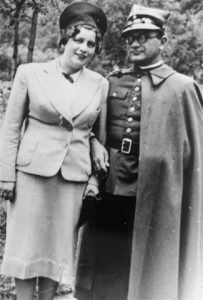
In September 1939, Major Baruch Steinberg served as the chief rabbi of the Polish Army. Sadly, few will be surprised to learn that Major Steinberg was brutally murdered in the wake of the German invasion of Poland that month. After all, an estimated 3,000,000 Polish Jews were eventually murdered in the Holocaust. What may come as a surprise is that it was not the Nazis who killed Major Steinberg. Rather, it was the other totalitarian power that invaded Poland in September, 1939, the Soviet Union, that murdered him, along with over 21,000 other Poles over the course of April and May 1940. Today, March 5, marks the 75th anniversary of the document that would send Major Steinberg and the others to their deaths.
On September 17, 1939, the Soviet Union invaded Poland, in accord with the treaty it negotiated with Nazi Germany the previous month. As a result of its invasion, the USSR gained over half of pre-war Poland, more than 77,000 square miles, as well as over 12 million people. The occupied regions were soon annexed to the neighboring Soviet republics of Ukraine and Belorussia (now Belarus).
In the course of their invasion, the Soviets are estimated to have captured 240,000 Polish troops. While many of the enlisted men were released, over 14,000 Polish officers, along with police, border guards, officials and others, were kept in custody. They were dispatched to three major prison camps: Kozelsk, in western Russia; Starobelsk, in present-day Ukraine; and Ostashkov, northwest of Moscow. The camps were under the control of the Soviet secret police, known then as the NKVD.
For approximately five months, the Polish prisoners were subjected to Soviet propaganda and interrogated on their attitudes toward the USSR while the Soviets considered what to do with them. By early March, the Soviet authorities had come to a decision. On March 5, 1940, Lavrenty Beria, head of the NKVD, sent a memorandum to Soviet dictator Josef Stalin that sealed the fate of the prisoners:
In the USSR NKVD prisoner-of-war camps and prisons of the western regions of Ukraine and Belorussia, there are at present a large number of former officers of the Polish Army, former workers in the Polish police and intelligence organs, members of Polish nationalist c-r parties … and others. They are all sworn enemies of Soviet power, filled with hatred for the Soviet system of government. (Cienciala, p. 118; emphasis added)
According to Beria, there were a total of 14,736 prisoners held in the three camps. Beria recommended that these men (only one was a woman), along with 11,000 Polish prisoners held in NKVD prisons, be dealt with via “the supreme measure of punishment, [execution by] shooting.” (Cienciala, p. 120; emphasis added)
Beria’s recommendation was unanimously approved by Stalin and the Politburo. Beginning on April 3, groups of prisoners from each of the three camps were taken to special NKVD execution facilities and shot. By the time the operation ran its course in late May 1940, the NKVD had killed 14,552 of the Poles held at Kozelsk, Ostashkov, and Starobelsk, along with 7,305 additional victims held in regular NKVD prisons. Major Steinberg, along with over 40 other Polish military chaplains, would be among those murdered. The families of those executed were rounded up by the NKVD and deported to special settlements in Kazakhstan, where many died in difficult conditions.
In April 1943, the Germans discovered the site in the Katyn Forest, near the Russian city of Smolensk, where the Kozelsk prisoners were murdered, and announced the discovery to the world. The Soviets denied the German charges, and declared that the Nazis were responsible for the crime. Not until 1990 did the USSR admit responsibility for murdering the Polish prisoners. While only about 20% of the overall number of victims were killed at Katyn, the entire mass killing has became known as the Katyn Forest Massacre. Despite occasional attempts at reconciliation, Katyn continues to haunt Russo-Polish relations to the present day.
1. Sources on Katyn
Cienciala, Anna M., Natalia S. Lebedeva, and Wojciech Materski. Katyn: A Crime Without Punishment. New Haven: Yale University Press, 2007. (Joyner Stacks D804 .S65 K359 2007)
Fischer, Benjamin B. “The Katyn Controversy: Stalin’s Killing Field.” Studies in Intelligence, Winter 1999-2000. https://www.cia.gov/library/center-for-the-study-of-intelligence/csi-publications/csi-studies/studies/winter99-00/art6.html
The Katyn Forest Massacre. Hearings before the Select Committee to Conduct an Investigation of the Facts, Evidence and Circumstances of the Katyn Forest Massacre, Eighty-Second Congress, First[-Second] Session. 7 v., 1952. (Joyner Docs CWIS: Y 4. K 15: M 38/)
Paczkowski, Andrzej.”Poland, ‘The Enemy Nation’.” in Stephane Courtois and Mark Kramer (eds.) The Black Book of Communism: Crimes, Terror, Repression. Cambridge, MA: Harvard University Press, 1999. (Joyner Stacks HX44 .L5913 1999)
Paul, Allen. Katyn: Stalin’s Massacre and the Triumph of Truth. DeKalb: Northern Illinois University Press, 2010. (Joyner Stacks D804 .S65 P378 2010)
Snyder, Timothy. Bloodlands: Europe Between Hitler and Stalin. New York: Basic Books, 2010. (Joyner Stacks DJK49 .S69 2010)